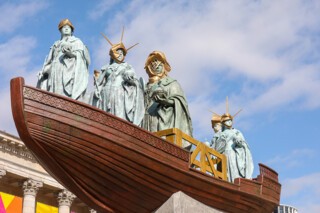In Victoria Square
Daniel Trilling
At first sight, as you walk uphill along New Street, it looks as if a UFO has landed in Birmingham’s Victoria Square. As you get closer, it turns out to be a boat, stranded in mid air – on top of what used to be a statue of Queen Victoria, outside the city’s council buildings. Victoria stands in the middle of the boat, surrounded by four smaller replicas. The cloned queens are all looking outwards, their bodies pointing in the direction of travel. But the boat isn’t going anywhere, fixed as it is to the top of a plinth.
Hew Locke’s Foreign Exchange, a temporary sculpture commissioned to mark the arrival of the Commonwealth Games in Birmingham this summer, hasn’t replaced the bronze statue that usually stands there (itself a replica, cast in 1951 for the Festival of Britain, of a marble original from 1901). Locke has constructed a removable resin shell that fits over the monument. His replica Victorias have been modified, wearing warrior-like golden helmets and medallions that commemorate moments of British imperial conquest: the Second Afghan War, the sacking of Benin, the defeat of Tipu Sultan.
When the sculpture was unveiled in mid-June, the Birmingham Mail tried to confect a culture war row, complaining that visitors to the games wouldn’t be able to see a ‘classic view’ of Birmingham and quoting a member of the local civic society who described Locke’s statue as ‘woke rubbish’. A more telling comment, however, came from the right-wing pressure group Save Our Statues – set up after the toppling of Edward Colston in Bristol in 2020 – who were upset the sculpture hadn’t caused more outrage. ‘In an age of “offence”, I honestly don’t understand why the offence this has caused doesn’t seem to count?’ a spokesperson tweeted.
Perhaps people actually find the sculpture attractive. In Victoria Square, surrounded by the greys and browns of 19th-century municipal architecture, the green and gold of the replica Victorias catch the sun. On a bright day, the helmets glitter in concert with the mosaic above the entrance to Birmingham’s Council House, which celebrates the manufacturing-age virtues of Science, Art, Liberty, Law, Commerce and Industry.
Locke, a British sculptor with roots in Guyana, is becoming a popular choice for institutions that want to commission works that address the legacies of empire, colonialism and global wealth accumulation. The Procession, in the Duveen Galleries at Tate Britain until next January, gathers together more than a hundred human figures wearing carnival costumes and carrying multicoloured banners. Later this year, Locke will redecorate the façade of the Metropolitan Museum of Art in New York.
His work, however, as a retrospective at Birmingham’s Ikon gallery in 2019 made clear, is far from cosy. Skeletal apparitions from Guyanese folklore float over doctored pictures of monuments. Antique share certificates, used to raise cash for colonial ventures, have been overlaid with paintings of refugees in boats. Some of the imagery reappears on the carnival banners in The Procession.
But it’s the unpredictability of Locke’s art as much as its themes that makes it so unsettling. The excess of decoration, which the art historian Kobena Mercer describes as ‘postcolonial baroque’, gives the work an improvisational feel. In Birmingham, the redecorated Queen Victoria invites a double take. Why are there five of her? Why are they wearing helmets?
‘Statues are so invisible, people walk past them all the time,’ Locke told me at the unveiling. This was a way of making an everyday symbol of British history – the kind we walk past daily in town centres across the country – newly visible. He hoped it would make people ask: ‘Why are we here?’ If anyone’s upset by that, it may be because they don’t like the answers the question provokes.
